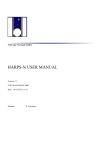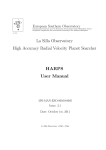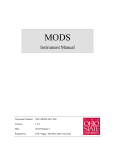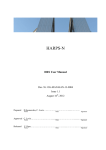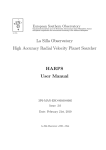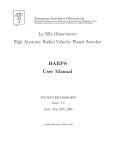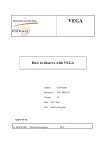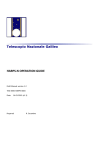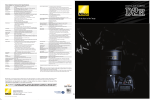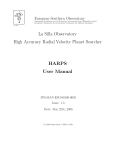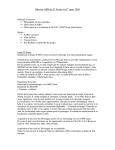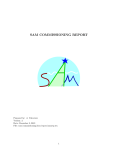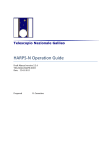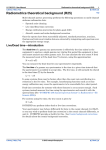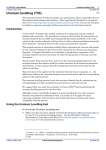Download HARPS-N USER MANUAL - TNG
Transcript
Telescopio Nazionale Galileo HARPS-N USER MANUAL Draft Manual version 1.2 TNG-MAN-HARPN-0002 Date: 24-04-2012 (v1.0) Prepared R. Cosentino TNG-MAN-HARPN-0002 2 Change Record Issue/Re v. V1.0 V1.1 V1.2 Date Section/Page affected 24-04-2012 18-01-2013 28-01-2013 First version First revision changes Reason/Remarks TNG-MAN-HARPN-0002 3 1 Contents 2 3 Introduction ......................................................................................................................................6 2.1 Scope ........................................................................................................................................6 2.2 Additional information ...............................................................................................................6 2.3 Contact information ................................................................................................................6 2.4 Acknowledgments ...................................................................................................................6 HARPS-N Characteristics ..................................................................................................................7 3.1 Instrument Overview ..................................................................................................................7 3.1.1 3.2 Operational overview ............................................................................................................... 10 3.2.1 Fiber link ......................................................................................................................... 10 3.2.2 Calibration unit (CU) ........................................................................................................ 10 3.2.3 Front End Unit (FEU) ....................................................................................................... 11 3.3 4 Instrument coupling to the telescope ....................................................................................9 Detector and read out electronics .............................................................................................. 13 3.3.1 General detector characteristics ......................................................................................... 13 3.3.2 CCD ................................................................................................................................ 13 3.3.3 Cryostat ........................................................................................................................... 14 3.3.4 CCD controller ................................................................................................................. 14 3.3.5 Shutter ............................................................................................................................. 14 3.3.6 Exposure meter................................................................................................................. 14 3.4 Software architecture................................................................................................................ 14 3.5 Data acquisition software.......................................................................................................... 15 3.5.1 Short Time Scheduler (STS) .............................................................................................. 15 3.5.2 Sequencer......................................................................................................................... 16 3.5.3 Front End Unit, Autoguider and Calibration Unit control (instrument software) ................... 16 3.5.4 Telescope Control System ................................................................................................. 16 3.6 Data Reduction Software .......................................................................................................... 18 3.7 HARPS-N performances........................................................................................................... 19 3.7.1 Spectral format and resolution ........................................................................................... 19 3.7.2 Efficiency of the spectrograph ........................................................................................... 21 3.7.3 Instrumental stability and simultaneous reference ............................................................... 23 3.7.4 On-sky precision............................................................................................................... 24 Observing mo des ....................................................................................................................... 25 4.1 Simultaneous Thorium reference method ....................................................................... 25 4.1.1 Performance ..................................................................................................................... 25 4.1.2 Calibrations ...................................................................................................................... 25 4.1.3 Observations .................................................................................................................... 27 4.1.4 Pipeline, data reduct ion............................................................................................. 27 4.2 Simultaneous Fabry Perot reference method.................................................................. 27 4.2.1 Performance ..................................................................................................................... 27 TNG-MAN-HARPN-0002 4.2.2 Calibrations ...................................................................................................................... 27 4.2.3 Observations ................................................................................................................. 28 4.2.4 Pipeline, data reduct ion............................................................................................. 28 4.3 Classical fibre spectroscopy .............................................................................................. 28 4.3.1 Performance ..................................................................................................................... 28 4.3.2 Calibrations ...................................................................................................................... 28 4.3.3 Observations ................................................................................................................. 28 4.3.4 Pipeline, data reduct ion............................................................................................. 29 4.4 Focusing of the telescope.......................................................................................................... 29 4.4.1 Performance ..................................................................................................................... 29 4.4.2 Template .......................................................................................................................... 29 4.5 5 RV acc uracy ......................................................................................................................... 29 4.5.1 Photon noise ................................................................................................................ 29 4.5.2 Telescope focus ............................................................................................................ 29 4.5.3 Ce ntering errors .......................................................................................................... 30 4.5.4 Thorium calibration errors ....................................................................................... 30 Preparin g the observat ions ........................................................................................................ 30 5.1 Introduction .......................................................................................................................... 30 5.2 Introducing Observing Blocks ........................................................................................... 30 5.2.1 O bs er ving bloc ks .................................................................................................................. 30 5.2.2 New Short T ime Scheduler (NST S) .............................................................. 30 5.2.3 Science templates ........................................................................................................ 31 5.2.4 Calibrat ion templates ................................................................................................. 31 5.2.5 Technical templates .......................................................................................................... 32 5.3 Overheads ............................................................................................................................. 33 5.3.1 5.4 6 7 4 Fast time series observations (asteroseismo lo gy)................................................... 34 The HARPS- N Exposure Time and Spectral Format Calculator ............................. 34 Observing w ith HARPS ........................................................................................................... 36 6.1 Before the night................................................................................................................... 36 6.2 During the night.................................................................................................................. 36 6.2.1 Tar get acquisit io n, guiding, fo cus ing ....................................................................... 36 6.2.2 Point ing restrict ions ................................................................................................... 36 6.2.3 Night calibrations ....................................................................................................... 37 6.2.4 Real-time display ........................................................................................................ 37 6.3 Observing very faint stars ................................................................................................. 37 6.4 Asteroseismology................................................................................................................ 37 6.5 End of the night ................................................................................................................... 37 Data pro ducts and archivin g ...................................................................................................... 39 7.1 Data products ...................................................................................................................... 39 7.1.1 Raw data file................................................................................................................... 39 7.1.2 Reduced data file .............................................................................................................. 39 TNG-MAN-HARPN-0002 7.2 8 5 Data archiving ..................................................................................................................... 40 7.2.1 TNG and Trieste archives.................................................................................................. 40 7.2.2 TNG data logging ......................................................................................................... 40 7.2.3 Use of archived HARPS-N data ................................................................................. 41 The Reduction of HARPS-N Data .................................................................................................... 43 The HARPS-N data reduction pipeline ................................................................................................. 43 High accuracy radial velocities................................................................................................... 43 A.1 Data naming rules ......................................................................................................................... 43 A.2 Data formats ................................................................................................................................. 43 TNG-MAN-HARPN-0002 6 2 Introduction 2.1 Scope This User Manual is intended to give all necessary information to potential users of the HARPS-N instrument, to help them decide on the opportunity to use the instrument for their scientific applications, to be used as a reference when writing observing proposals and when preparing the observations. For this purpose we give • An overall description of the HARPS-N instrument, its performance and its observing modes; • Inform ation on the preparation of the observations; • Inform ation on the observing process; • A description of the HARPS-N data and near real-time pipeline data reduction The following documents are closely related to this manual and should be consulted as well: The HARPS-N Startup Manual (TNG -M A N -H A RPN -0001) The New Short Term Scheduler User Manual (NSTS) The DRS User Manual (OG-MAN-HAN-13-0004) Both are available through the TNG web page http://www.tng.iac.es/instruments/harps/ 2.2 Additional information The latest information up dates ab out the HARPS-N instrument can be found on the HARPS-N web pages https://plone2.unige.ch/HARPS-N/harps-n-operations-and-observations 2.3 Contact information 2.4 Acknowledgments Most of the conte nts of this manual is based on information from the HARPS-N Cons ortium (Astronomical Observatory of the Geneva University (lead), the Harvard-Smithsonian Center for Astrophysics in Cambridge (USA), the Universities of St. Andrews and Edinburgh, the Queens University of Belfast, and the TNG-INAF Observatory). Releases of this document are based on the ESO HARPS User Manual edited by G. Lo Curto. Feedback on this User Manual from users is encouraged. Please email to [email protected] TNG-MAN-HARPN-0002 7 3 HARPS-N Characteristics 3.1 Instrument Overview HARPS-N (High-Accuracy Radial-velocity P lanetary Searcher) is an instrument designed for the measurement of Radial Velocities (RV) at highest accuracy. The HARPS-N Project is collaboration between the Astronomical Observatory of the Geneva University (lead), the Harvard-Smithsonian Center for Astrophysics in Cambridge (USA), the Universities of St. Andrews and Edinburgh, the Queens University of Belfast, and the TNG-INAF Observatory. The project started in 2006, but suffered a two year delay due to financial problems. After a re-organization of the project in 2010 it was successfully completed in less than two years. In March and April 2012, HARPS-N was installed at the Nasmyth B Focus of the 3.6m TNG, at the Observatory of the Roque de los Muchachos, La Palma Island. The first commissioning took place in April and the first scientific observation started on May 21st . Its purpose is to reach a long term radial ve lo c it y accuracy of 1 m/s for slowly rotatin g G-dwarfs. Su ch precision enables the detection of low mass (Saturn like) extra-solar planets and low amplitu de stellar oscillations. The design of HARPS-N is based on the experience acquired with HARPS (installed at 3.6m telescop e in La Silla) The b a s ic design of HARPS-N is therefore very similar to this instrument. The efforts to increase the HARPS-N performance compared to HARPS address mainly three issues: Increase of the input beam stability: To send the light from the FEU to the spectrograph we use a 26 m octagonal fiber link. This new geometry increases the light scrambling effect and guarantees a very high precision in radial velocity measurement, since they minimize spectrograph illumination changes due to the positioning error of the star in the fiber entrance. Increase the reference precision: Two external high-precision references are included. The first is already available and consists of an ultra-stable Fabry-Perot interferometer. The second one, a stabilized laser-frequency comb, is currently under development and will become available in 2013 Impr ovement of the image quality and quantum efficiency: The CCD is a 4Kx4K, backilluminated e2v CCD231 with 15m square pixels. It is a device processed from standard silicon process and coated with graded AR coating parallel to the readout directio n for enhanced response from 385nm to 691nm from left to right. HARPS-N is a fiber-fed, cross-dispersed echelle spectrograph, based on the design of its predecessor working at ESO 3.6m. This successful spectrograph already has proven its capability to achieve a precision better than 1 meter per second and revealed several super-earth planets in the habitable zone. Two fibers, an object and a reference fiber of 1 arcsec aperture pick up the light at the Nasmyth B focus of the telescope and feed the spectrograph either with calibration or stellar light. The fiber entrance is reimaged by the spectrograph optics onto a 4k×4k CCD, where echelle spectra of 69 orders are formed for each fiber. The covered spectral domain ranges from 385nm to 691 nm. The resolution of the spectrograph is given by the fiber diameter and reaches an average value of R = 115000. At this resolution each spectral element is still sampled by 3.3 CCD pixels. The spectrograph is mounted on a nickel plated stainless steel mount and contains no moving parts. Furthermore, in order to avoid spectral drifts due to temperature and air pressure variations, it is accurately controlled in pressure and temperature. In Figure 1 the mechanical mount (on the left) and the installation inside the vacuum vesse l (on the right) are shown. A summary of the main HARPS-N characteristics is given in Table 1. TNG-MAN-HARPN-0002 8 Figure 1 – HARPS-N mechanical design and vacuum vessel Table 1 - Harps Main Characteristics Spectrograph type Fiber fed, cross-dispersed echelle spectrograph Spectral resolution Fiber field Wavelength range Total efficiency Sampling Calibration CCD Pixel size Environment Global short-term precision Global long-term precision Observational efficiency wavelength accuracy R = 115’000 FOV = 1” 385 nm - 691 nm e = 8 % @ 550 nm (incl. telescope and atmosphere @ 0.8" seeing) s = 3.3 px per FWHM ThAr + Simultaneous reference (feed by 2 fibers) Back illuminated CCD 4k4 E2V chips (graded coating) 15 µm Vacuum operation - 0.001 K temperature stability 0.3 m/s (10E-9) better than 0.6 m/s (2x10E-9) SNR = 50 per extracted pixel on a Mv=8, TExp = 60 sec 60 m/s (2x10E-7) on a single line All necessary moving parts are located in the HARPS-N Front End Unit (FEU), with the exception of the shutter, which is located just outside of the vacuum vessel. The optical design, shown in Figure 2, is similar to HARPS-S Figure 2 - Optical layout of the spectrograph Its echelle grating is op erated in quasi-Littr ow conditions (off plane angle = 0.721 deg blaze angle) TNG-MAN-HARPN-0002 9 and the collimator in triple pass mode. A white pupil configuration has been adopted with the cross disp erser placed at the white pupil. The dioptric camera images the cross-dispersed s pect rum on a detector. Two fibres (A and B) feed the sp ectrograph, one ob ject fibre and one reference fibre (science fibres). The sp ectra of the light from b oth fibres are formed by the sp ectrograph side by side on the detector. Alth ou gh all care has been taken to avoid stray light and gh osts, b oth are present at some level, most noticeably in the blue part of the sp ectrum. Ghosts seem to be due to th ird order reflections in the grism (see T able 1 and 2 for some characteristic values). However, the dom inant effect is cross-contamination between the two fibers. In the worst case, a t (physica l) echelle order nr. 92, the contamination is of the level of 1.5% after extraction. In avera ge, however, the cross contamination between the two fibers is of the order of 0.5%. and in 68 of 70 echelles order lower than 1%. The instrument is coupled to the telescop e throu gh an adapter: the HARPS-N Front End Unit (FEU). Two calibration fibers trans mit the light from the calibration unit located in the Nasmyth B Focus and inject it in the two science fibers for calibration. Table 2 - Halogen lamp (3000k) - Level of diffuse + stray light and ghosts as a percent of the flux in the order Order n. Wavelength (nm) Diffused + stray light Ghosts 90 116 680 527 0.2% 0.4% 0.05% 0.5% 159 385 ≈ 1% 1% Table 3 - G3V star (5700 K) - Level of diffuse + stray light and ghosts as a percent of the flux in the order Order n. 90 116 159 Wavelength (nm) 680 527 385 Diffused + stray light 0.2% 0.3% < 1% Ghosts < 0.2% 0.2% < 2% In the following is presented a brief description of the HARPS-N comp onents: the fibre adapter on the telescop e, the calibration unit, and the fibre links connectin g these comp one nts. A sophisticated online data reduction pipeline is also part of the system (section 8). 3.1.1 Instrument coupling to the telescope The instrument comprises two parts: the spectrograph which is located in the ground floor of the telescope and the Front End and Calibration unit which it is mounted on the telescope Nasmyth B fork. An optical fiber link sends the light from the Front End Unit to the spectrograph. Figure 3 show the schematic view. TNG-MAN-HARPN-0002 10 Figure 3 - HARPS-N general schematic view 3.2 Operational overview The HARPS-N instrument is mou nted on the Nasmyth B focus of the TNG telescop e in La Palma. It shares the focus with other instruments: Dolores and SARG. The switch between the three instruments r e q u ir e s only the movement of M4 mirror (entrance slider) 3.2.1 Fiber link To send the light from the FEU to the spectrograph we use a 26 m octagonal fiber link. This new geometry increases the light scrambling effect and guarantees a very high precision in radial velocity measurement, since they minimize spectrograph illumination changes due to the positioning error of the star in the fiber entrance. These fibers have shown excellent laboratory performances, and demonstrated excellent results on sky. A second fibre link con nects the Fabry P erot reference, next to the sp ectrograph with the HARPSN Calibration Unit (CU) 3.2.2 Calibration unit (CU) The calibration unit contains the lamps and the power supply and provides the reference source (thorium, tungsten) for the FEU. Two external high-precision references are included. The first is already available and consists of a Fabry-Perot interferometer. The second one, a stabilized laser-frequency comb, is currently under development and will become available in 2013. The CU is connected via two optical fibres to the FEU which redirects the light of the calibration sources into the sp ectrograph fibres as required. The two calibration fibres can be fed either by the same or indep endently by tw o different calibration sources. Of the two T horium-Ar gon lamps, the lamp THAR1 is the absolute reference, and its use should be minimized. Typically it is used for 5 minutes per day during th e afternoon calibrations, shining on “fibre A”. The lamp named “THAR2” is used to measure th e instrument drift in parallel with the science observations. The lamp can b e switch on at any mome nt. It is particularly useful when one of the other lamps burns out in the course of th e night. The HARPS-N Calibration Unit has two linear mechanisms to move the reference fibers between 5 positions. Three of the positions have lamps, two of which are Thorium -Argon hollow cathode lamps while the other one is a filament halogen lamp. The others two positions are used for ultra -stable externa l references which can be fed through an optical fiber connection. At the moment one of these positions hosts the Fabry-Perot interferometer, located in the HARPS-N cabinet, close to the spectrograph. TNG-MAN-HARPN-0002 11 Table 4 - CU components Movement/component Thorium lamps 1 and 2 Halogen lamp Fabry-Perot Description The Thorium Argon lamps are type 4160AHP from S&J Juniper & Co. The halogen lamp is a type 6337 (TBC) Quartz Tungsten Halogen bulb from Newport The FP interferometer is located close to the spectrograph 3.2.3 Front End Unit (FEU) The FEU is the first part of the spectrograph where the incoming light from the telescope and from the calibration unit is conditioned and collimated in the fibers. In this stage the incoming beam from the telescope is corrected by the atmosphere dispersion corrector (ADC). The star is maintained in the fiber thanks to the tip-tilt mirror acting together with the autoguider system. The folding mirror selects which object/reference configuration has to be put into the fibers. The optical scheme in Figure 5 shows the optical path inside the FEU and the main components. Table 5 - FEU components Movement/component Calibration fold mirror Dust Cover Guide camera Guide camera ND filter Calibration ND filter ADC prism Tip-tilt mirror Description linear mechanism with 4 fixed positions linear mechanism with two positions (open/close) FLI PL47-20 (TBC). Connection to the LCU in the control rack is via USB Two rotating wheels, with three filters and a transparent glass each, producing attenuation density from 0 to 6 (factor 1 to 1’000’000) Two rotating wheels with unconstrained motion (can be set to any position in 360 deg). Attenuation range of 1 to 300. Two atmospheric density compensation prisms with unconstrained motion Precision piezo motor and strain gauge position sensors Figure 4 Calibration and Front End Units TNG-MAN-HARPN-0002 12 Figure 5 – FEU optical scheme Figure 6 - The Front End Unit All optical fibres are connected to the FEU which forms the interface to the telescop e. The FEU provides several functions: 1. Illumination of the ob ject and the reference fibres; each can be separately fed by the ob ject, the sky, light from a calibration source, or it can be dark. 2. Correction of atmosp heric dispersion by means of an ADC. TNG-MAN-HARPN-0002 13 3. House the technical CCD camera for guiding. 4. Guide the star in the fibre thanks to the tip-tilt mirror acting together with the autoguider system 6. Attenuatin g the reference light beam from the ThAr lamp via a neutral density wheel to an equivalent exposure time of 20s at zero density. This can be done for exposure times from 20s to 5400s. 3.3 Detector and read out electronics 3.3.1 General detector characteristics The HARPS-N scientific camera is based on an e2v CCD231 scientific grade CCD detector and an ARC generation III CCD controller. The detector has been integrated in a continuous flow cryostat (CFC) supplied by ESO. The CCD controller allows different readout modes (1, 2 and 4 output readout) and different binnings, but to optimize the automatic data reduction pipeline and the operations we chose only two fixed configurations of the acquisition mode: The detector is configured without binning and the readout is using two outputs. The readout speeds is 500 kHz per channel, and the readout noise is < 5e. The electronic conversion factor is about 1.6 e/ADU. The HARPS-N science detector system is summarized in Figure 7. Figure 7 – Detector control system scheme 3.3.2 CCD The CCD is a 4Kx4K, back-illuminated e2v CCD231 with 15m square pixels. It is a device processed from standard silicon process and coated with graded AR coating parallel to the readout directio n for enhanced response from 385nm to 691nm from left to right as shown in Figure. The CCD is read by two different amplifiers and a difference of several 100 ADUs in the bias leve l of the two CCDs might be exp ected. Following we present the CCD Quantu m effic ienc y curve as provid ed by the supplier. Figure 8 – The CCD coating and quantum efficiency TNG-MAN-HARPN-0002 14 3.3.3 Cryostat An ESO supplied continuous liquid nitrogen flow cryostat houses the CCD and a preamp lifier board. A dedicated controller regulates the LN flow control to maintain the temperature of the base plate inside the cryostat at a suitable temperature. The CCD mount stage will have a separate temperature control system using a Lakeshore controller to maintain the CCD temperature at its operating value. 3.3.4 CCD controller The HARPS-N Camera control and data acquisition system (UCam) uses the controller hardware from Astronomy Research Cameras, Inc. USA (ARC Controllers). The ARC controller provides all the bias voltages and clocks required to operate the detector and process the CCD video signal. 3.3.5 Shutter A 45mm clear aperture bi-stable Uniblitz shutter is mounted just outside the spectrograph vessel to get the timed science exposures. The shutter is controlled by its own controller and is located in the detector electronics rack close to the spectrograph. The control input to the shutter controller is derived from the ARC controller. 3.3.6 Exposure meter The sp ectrograph possesses an exposure meter which serves to measure the stellar flux and to accurately measure the mid-time of the exposure (flux weighted mean of the time). This exposure meter consists of two photomultipliers (one for each of the two fibres enterin g the sp ectrograph from the FEU) which use the light picked up at the gap b etween the two sub- gratings of the echelle mosaic; no light is lost due to this design. The flux in b oth photomultipliers can be read at the instrument console. It is also recorded in the FITS header (cumulative, average and center of gravity). The exp ected cou nt rates as a function of stellar magnitude and the estimated errors in RV are given in table( Ad d t h e t a b le - - - M v, c o u nt s , er r o r - t im e , R V e r ro r ) . The number of dark cou nts per second fluctuates b etween 10 and 15. How eve r, the dat a-re duc t io n p ipe line is curre nt ly not us in g th is va lue to co rre ct fo r pos s ib le de par ture s fr om th e no m in a l 0.5 v a lu e (centered exposure). 3.4 Software architecture HARPS-N SW is organized in modules, chained together by the Data Flow System. First, the chosen targets are scheduled for observation with the new short-time scheduler (N-STS), where their parameters are organized in Observation Blocks. The prepared OBs are sent on request to the Observation Contro l System - the Sequencer. When an OB is get into the OCS, all the instrument subsystems are set up according to its definition: the telescope, the spectrograph and the detector. Once the observation has been executed, the raw image with the FITS keywords gathered from all the subsystems is registered. Then the appropriate data reduction recipe is automatically triggered by the ‘Trigger’ software and the raw data are reduced. TNG-MAN-HARPN-0002 15 Figure 9 - The HARPS-N software architecture 3.5 Data acquisition software The camera control and data acquisition system (UCam) operates under PC control, running RTLinux, interfaced to a Generation-III ARC Controller. The software can be run remotely with a network connection to the host computer. The UCam software runs on three HTTP server processes; Camera Control, File Save and Data De-multiplexer servers. The Camera Control server initializes, configures, downloads and executes applications. The File Save server handles the image data and writ es to disk a meta-data file. It also contains instructions to sample and de-multiplex the raw data image. The Demultiplexer server processes the saved data and saves it in FITS file format. A GUI client application is used for controlling the UCam server application. 3.5.1 Short Time Scheduler (STS) STS is the application which allows the user to prepare the observations. It helps the astronomer to choose and schedule the targets for the observing night, as well as to calibrate the instrument. Within the STS the exposures are organized in blocks, called the Observation Blocks, of three types: science, calibration and technical. Science OBs contain the parameters for the target acquisition, the instrument and the detector set-up. Calibration OBs describe the calibration exposures. Technical OBs define the instrument initialization and the start and end procedures of the observing night. STS controls the feasibility of the scheduled exposures with respect to the observational conditions and constraints, like the limit airmass, out-of-the-night placement etc. The Exposure Time Calculator, which is part of the STS, helps the user to optimize the exposure time depending on the SNR and vice versa. The STS GUI is shown on Figure 10. TNG-MAN-HARPN-0002 16 Figure 10 - Short Time Scheduler screenshot 3.5.2 Sequencer The sequencer is the HARPS-N observation control software. It gets the observation blocks from the STS, and executes them according to several XML template files. Sequencer templates files define the commands, statements and variables to run an Observing Block. Moreover the sequencer is able to emulate HARPS-N units and display, through a GUI, the execution status for each of the commands defined in the command template file ( Figure 11). 3.5.3 Front End Unit, Autoguider and Calibration Unit control (instrument software) The FEU and CU software are LabView modules which controls the movements and settings of the instrument and the autoguider . This software can also control the units in stand-alone mode as an engineering interface or by the HARPS-N sequencer using an XML-RPC interface. 3.5.4 Telescope Control System HARPS-N has an interface to the TCS. This interface enables the instrument to send commands to the telescope via the TNG library. Currently HARPS-N is able to send three commands; Pointing, AG offsets and M2 offsets to calculate and correct the focus via an automatic procedure. The connections between both systems are completely asynchronous but when the command finishes successfully the TCS returns an Ok status. When an error condition has arisen, the TCS also returns a message back to the sequencer flagging that condition. TNG-MAN-HARPN-0002 Figure 11 - Sequencer GUI screenshot Figure 12 – FEU screenshot. Autoguider and Front End Monitor. 17 TNG-MAN-HARPN-0002 18 3.6 Data Reduction Software An automatic data reduction system (DRS) is included with HARPS-N to reduce, shortly after the exposure, observations for "classical" spectroscopy and high-precision Doppler measurements with simultaneous wavelength reference. For science exposures, the DRS outcomes are flat-fielded, wavelength-calibrated spectra and, when possible and requested, barycentric radial velocity of the target. Calibration exposures are used by the DRS to calibrate the instrument for best-quality scientific reduction. The DRS is designed to run automatically like a batch process on the archived frames. All relevant parameters required by the DRS are passed to the DRS through the FITS headers of the archived frames. Results of the DRS are stored in the FITS keywords of reduced frames. The top level of the DRS is represented by a set of programs (recipes) performing the various calibration and science tasks. They take as inputs the raw data produced by the instrument and are executed on line. Each raw product has its associated DRS recipe which performs the required reduction tasks. An additional top layer application - Trigger - acts as an automatic on-line recipe launcher. The role of the Data Reduction Software (DRS) is to transform the raw data produced by the instrument into reduced data of scientific quality. These represent the basic products from which the user will start in order to perform the desired specific analysis. Therefore, the endpoint of the DRS processing is defined as the furthest stage at which the data products are still sufficiently generic to be used as inputs for all main HARPS-N science cases. The main steps of the scientific data reduction are: Bias and dark subtraction Bad pixels correction Background subtraction Order extraction with cosmic rejection Flat-fielding Wavelength calibration Merging and rebinning of the spectral orders Sky subtraction (if applicable) Instrumental drift correction (if applicable) Flux calibration Cross-correlation with a numerical template Radial velocity computation For HARPS-N the final products of the DRS process have been found to be the extracted, background subtracted, cosmic-corrected, flat-fielded and wavelength-calibrated spectra (with and without merging of the spectral orders). The possibility to flux-calibrate the spectra is also available. These products are provided also for the reference fiber (sky or simultaneous wavelength calibration) if applicable. In addition to these reduction products, cross-correlation functions of the spectra are also computed to provide high-precision radial velocities. One important feature of the DRS environment is the calibration database, in which all calibration products needed to reduce science data are stored. The complete calibration database can be accessed at any time by the DRS recipes, which always choose the best available calibration dataset. TNG-MAN-HARPN-0002 19 Figure 13 – Screenshot of the data-reduction trigger 3.7 HARPS-N performances 3.7.1 Spectral format and resolution The recorded spectral format corresponds well to the calculated values (Table 6) gives the order number, central wavelength and the total spectral range covered by the respective echelle order at the top, center, and bottom of the CCD. All the orders up to #158 could be localized and extracted using a tungsten flat field lamp, while the wavelength calibration was done using the ThAr spectral lamp, Figure 14 shows a part of the corresponding extracted and wavelength calibrated spectrum. Table 6 - Central wavelength and spectral range of the echelle orders Order N° 89 90 91 Central wavelength [Å] 6880.8 6804.4 6729.7 Total spectral range [Å] 75.9 75.1 74.3 156 157 158 3951.6 3926.3 3901.3 43.4 43.1 42.8 TNG-MAN-HARPN-0002 20 Figure 14 - Portion of the extracted ThAr spectrum order The image quality, and thus the spectral resolution, varies only slightly in the cross -dispersion direction (seeErro r! Reference source not found. Table 7). The variation is below 10% across the whole CCD. In main dispersion direction we encounter a larger spread in image quality of the order of 20%-30% increasing toward the red side of the echelle order due to expected anamorphism. This effect is however mostly compensated by the echelle-grating dispersion, which increases by about the same amount from the blue to the red side of the echelle order. Table 7 Image quality of the spectrograph. The FWHM of a spectral line expressed in pixels is indicated for different positions on the scientific CCD. X=0 X = 2000 X = 4000 Dispersion Cross-dispersion Dispersion Cross-dispersion Dispersion Cross-dispersion Y=0 Y = 2000 Y = 4000 3.2 3.1 2.8 3.2 2.9 3.3 3.2 2.9 3.0 3.1 3.2 3.2 3.7 3.1 4.0 3.8 4.1 4.2 The measured optical parameters are listed in Table 8. These have been determined by means of ThAr calibration exposures. The performances are all compliant with the specifications. The image quality could not be measured directly, thus we give here only a upper limit estimated from the FWHM values for the spectral lines given in Table 7. In order to compute the spectral resolution one has to multiply these values by the pixel size expressed in wavelength. At 530 nm for example, in the center of the CCD, the scale is 0.001415 nm/pixel, and the spectral resolution taking into account the measured spotsize is computed to about R = 124’000. Because of the changing dispersion and image quality along the orders the spectral resolution is not perfectly constant. Nowhere on the CCD the spectral resolution decreases below R = 100’000, however. Table 8 - Measured spectrograph parameters Wavelength range on the CCD Spectral resolution at center Order width (FWHM) at center Sampling at CCD center Separation of fibers 390.1 – 691.5 nm 120’000 3.2 pixels 0.0014 nm/pixel 16.8 pixels TNG-MAN-HARPN-0002 21 Figure 15 - Raw of a spectrum recorded by HARPS in the ‘wave’ mode. Two spectra can be distinguished, each one corresponding to one spectrograph fiber illuminated by A) the star (lower fiber) and B) the simultaneous FP (upper fiber). 3.7.2 Efficiency of the spectrograph The total calculated HARPS-N efficiency obtained at the center of the echelle order (blaze condition) is shown in Figure 16. The efficiency of various subsystems is also shown in the figure. The instrument efficiency has been computed using the efficiency data for each single optical component measured in the laboratory. The shape of the instrument efficiency follows the blaze response of the cross-disperser grism, the rapid cut-off below 380 nm is however accentuated by the band-pass filter which has been installed in order to prevent the second grism-order below 360 nm to be imaged on the CCD. For the CCD we indicate the QE-values measured in laboratory by E2V. Telescope and atmosphere efficiency have been estimated from experience values. The slit efficiency indicates an average value computed at an airmass Z = 1.03 and for an ‘effective’ seeing of 0.9 arcsec. In practice we estimate that 0.4 arcsec must be added quadratically to the seeing value to account for additional telescope effects due to image quality and possible defocus. TNG-MAN-HARPN-0002 22 Figure 16 - Total efficiency of HARPS-N (black plain curve, right-hand scale), and efficiency of subsystems (left-hand scale). The values have been calculated for each echelle order at its blaze wavelength. The fast drop below 380 nm is produced by a band-pass filter installed in the fiber-link to remove 2 nd -order of the grism. The grey area shows HARPSN’ spectral range. An interesting aspect is to measure the on-sky performances and derive the instrument efficiency. It is however almost impossible to calculate precisely the effective efficiency of the instrument by observin g standard stars, since the sky conditions, telescope focus, etc. are not known w ith sufficient accuracy. Therefore we prefer just to compare real measurements with calculated count rates. This procedure allows us to identify possible discrepancy without focusing on the detailed efficiency curve, which depends on too many observational parameters. Figure 17 shows the measured SNR as a function of wavelength obtained during one of the first GTO nights on May 24th, 2012. The used star was HD127334, a G5V star with mv = 6.36. The exposure time was of T exp = 120 sec and the observation were taken at an airmass of 1.03 and with a seeing of about 0.9 arcsec. The best measurement of this night is shown, since one has to be sure that efficiency losses due to effects not considered in the exposure-time calculator ETC (e. g. varying atmospheric extinction or telescope defocus) are minimized. The calculated curve was derived for a seeing of 1 arcsec, which actually has been chosen to take into account for the 0.4 arcsec image-quality losses discussed above. The measured signal-to-noise-ratio SNR is in excellent agreement with the calculated curve. The curve may slightly differ mainly because a) a K0 spectrum was used for the computation and b) the theoretica l values of some sub-components may be affected by small errors. On the other hand, and as mentioned above, other aspects such as seeing variations, extinction, image quality etc. cannot be controlled in detail. We conclude therefore that at a level of about 20% precision the expected efficiency matches the actual efficiency of the instrument. The radial velocity precision obtained on a given star depends on many factors, not the least being the stellar intrinsic noise or jitter. Nevertheless, even for a ‘quiet’ star, the obtained precision depends on the spectral line width, depths, and density, which all depend partially on the spectral type. In order to provide a bench mark for the transformation between SNR and expected radial-velocity precision, we focus on a quiet, non-rotating K0 dwarf. In this case, a SNR per extracte d pixel of about 50 is obtained on a star with mv = 8 in 60 s. At this SNR value a radial-velocity (photon-noise-limited) precision of the order of 1.3 m/s can be expected. TNG-MAN-HARPN-0002 23 Figure 17 - Measured signal-to-noise ratio SNR of HARPS-N (red curve) compared with the values computed by the exposure-time calculator of the STS (blue dcurve). The efficiency tests have be carried out on HD 127334, a mv = 6.36 G5 star. The exposure time was of 120 seconds. 3.7.3 Instrumental stability and simultaneous reference When observing in ‘wave’ mode, it is possible to feed fiber A with a ThAr spectrum and fiber B with the FP spectrum. By doing so, it is possible to a) track possible instrumental drifts and b) estimate the power of the ‘simultaneous reference’ technique. This technique is employed in HARPS-N to remove possible instrumental drifts from the stellar radial velocity: While calibrating the instrument or observing the star, the second spectrograph fiber B is always illuminated by a spectral reference source, in this case a FabryPérot (FP) etalon illuminated in white light. The stable FP records potential drifts of the instrument occurred between calibration and observation. Once expressed in terms of radial-velocity, the recorded value can be subtracted from the measured stellar radial velocity to correct for these drifts. We have done laboratory tests to measure the performances of the simultaneous reference technique. An example is shown in Figure 18, which shows the ‘radial velocity’ of the ThAr (fiber A) and FP (fiber B) spectral sources as a function of exposure number. Since one exposure was taken every minute, the series represents a time span of about 5 hours. During this time, we have made a ‘stress test’ of the instrument by pumping on the vacuum chamber and by changing the temperature of the detector dewar, both producing ‘absolute’ radial-velocity changes of several meters-per-second. The obtained results are very satisfactory: During the first hour, during which the instrument was not touched, the radial velocity remains stable well within the 1 m/s level. It must be noted that this means that the spectrum did not move, in absolute terms, by more than 0.001 pixels or 15 nm on the scientific CCD. This is actually the typical stability obtained with HARPS-N during a night, despite the fact that the thermal control system of HARPS-N has not yet been fully implemented. The dispersion on the drift measurements over this same 1-hour period is of the order of 30 cm/s. This “noise” has a typical period of 10 minutes. It is observed also on HARPS-N (south) and it is possibly due to tiny, but periodic temperature variations of the CCD or its dewar. It is important to note, however, that on the differentia l value one obtains a dispersion of 8 cm/s, which is almost identical with the combined photon -noise precision of the ThAr and FP spectral sources. This demonstrates without any doubt that the simultaneous reference technique is able to correct for drifts at the level of 10 cm/s and below. This statement is strengthened by the fact that, over the whole test duration, the differential drift never exceeded the 40 cm/s level, despite the fact that the instrument had been exposed to extreme stress conditions never occurring during standard operations. Furthermore, the differential drift appears to be compatible with zero after 5 hours, which not only confirms the power of the used technique but also demonstrates that our FP-based reference source is stable within 10 cm/s during an observation night. However, the FP does not yet provide the full stability on longer time scales, e.g. from day to day, probably because of a thermal instability of the temperature regulation. As long as this problem has not TNG-MAN-HARPN-0002 24 been solved, we recommend to observe in the standard simultaneous thorium mode or without simultaneous reference, in case of faint objects with m v > 12. Figure 18 -Short-term stability of the spectrograph and quality of the FP and ThAr tracking technique 3.7.4 On-sky precision HARPS-N makes use of octagonal optical fibers and a double scrambler, which, when combined, are supposed to perfectly scramble the light illuminating the spectrograph and thus remove any potentia l guiding effect on the measured radial velocity. On HARPS-N (south), an effect of the order of 3 to 4 m/s was measured when moving the star from the center of the fiber to the edge. This effect was observed to be symmetric with respect to the fiber center and fully understood as a consequence of differential pupil illumination of the spectrograph due to non-perfect scrambling by circular fibers. This experience led us to use octagonal fibers for HARPS-N. Tests in the laboratory had already shown that we could expect an excellent performance, but tests on the sky and using a ‘real’ star had to be performed. Summarizes the results of this test: During a night with good atmospheric seeing conditions (always below 1 arcsec) we have measured the radial-velocity of the star HD 89269. During this sequence we have alternatively centered and de-centered the star at the entrance of the optical fiber. The de-centering was of 0.5 arcsec, which means that the star was placed on the edge of the fiber, in the identical way we had done this on HARPS-N (south) in 2003. The first remarkable aspect is that the pmodes of the star (pulsation) of about 2 m/s semi-amplitude are directly visible in the temporal series. The second aspect concerns the excellent scrambling, and is represented by the fact that no discontinuity is observed in the radial velocities when switching from centered to de-centered observations. In order to estimate the off-guiding effect on the radial velocity we have averaged all centered exposures and compared them to all de-centered exposures. The difference in radial velocity is of the order of 0.5 m/s, which is in turn small compared to results obtained on HARPS-N (south). We consider this value to be actually an upper limit of the effect, since the measurement ‘noise’ is dominated by the stellar pulsation. This result is thus fully consistent with the laboratory measurement, which had indicated an improvement of about a factor 10 on the scrambling efficiency of octagonal fibers compared to circular fibers. At the moment of writing no long-term radial-velocity performances can be reported, given the fact that HARPS-N was installed in April 2012 and that the first GTO run took place from May 21 st to 25th, 2012. The radial-velocity dispersion over 2.5 hours and 41 exposures is of only 1.08 m/s; most probably this is completely dominated by the stellar p-modes. The same star was observed, although at much lower frequency, during all the four half nights of the first GTO run. The obtained dispersion is of the order of 1.5 m/s. We are convinced that this value will be improved further by optimizing the instrument and the data-reduction software. We expect that a long-term instrumental precision of the about 0.5 m/s can and will be attained after the first semester of operations. TNG-MAN-HARPN-0002 25 4 Observing modes HARPS-N offers the follow ing observing modes: Simultaneous Thorium Reference observation Simultaneous Fabry Perot Reference observation Classical fibre spectroscopy (with and without sky) 4.1 Simultaneous Thorium reference method The Simultaneous Thorium Reference mode is the base-line observation mode to get the b est short term accuracy in radial velocity determination from the instrument. In this mode fibre B is fed by the Thorium lamp while fibre A is on the stellar target. A variable neutral density (ND) filter is used to keep the Thorium sp ectrum at a flux leve l equivalent to a 40 seconds exposure with zero density. Since the density to which the ND filter is set is compu ted by the instrument software from the exposure time as defined in the template. The Thorium sp ectrum which is recorded simultane ously with the stellar sp ectrum is used t o compute the instrument drift from the last wavele n gth calibration, usually done at the beginning of the night. The calibration unit contains two identical ThAr lamps. For the simultane ous reference method only the lamp “T H AR2” can be used. The lamp “T H AR1” should be used as a reference only for the afternoon calibrations and s witch off afterwards. Ideally this should prolong the life time of this reference lamp. 4.1.1 Performance For estimates of the SNR in the HARPS-N mode under given observing conditions the Exp osure Time Calculator (ET C), inc lude d in the Ne w Sh ort Ter m Sched u ler (NST S), available via the HARPS-N web page http://obswww.unige.ch/~buchschn/ can be used with an accuracy of ab out 10%. The relationship b etween ph oton noise induced radial velocity error and S/N is given by the following formula: rms(m / s ) 100 S / N 550nm As a rule of thumb, an photon noise error of 1.3 m/s (or S/N = 50) can be achieved for a 8t h magnitu de K0-dwarf in 60 seconds in the HARPS-N mode. Note, that due to the small fiber ap erture on the sky (1′′ ), the performances assume a seeing better than 1” and critically d e p e n d o n seeing. 4.1.2 Calibrations The Simultane ous Thorium Reference Method needs a sequence of calibration exposures to be taken before the beginning of the night. No further calibration exposures are required during the night. In order to produce the correct calibration sequence the available observing block “RV Standar d Calibration” should be executed without changes before the beginning of the night. It includes: - 2 bias exposure. The CCD bias is very stable; only one bias is therefore needed by the pipeline. Template: HARPN_ech_ cal_ bias - 2 Tungsten lamp exp osures where resp ectively fibre A and fibre B are successively fed by the Tun gsten lamp. These exposures are used for order location which is done automatically by the TNG-MAN-HARPN-0002 26 pipeline. The processed products are stored in the calibration database if they pass the quality control of the pipeline, and used for the subsequent reduction of the scientific exposures of the following night. Template: HARPN_ech_ cal_ t u n - A sequence of 5 Tungsten lamp exposures (defined by N REP =5) where b oth fibres are simultaneously illuminated. This sequence is used by the data reduction pipeline for producing a sp ectral “master flat-field” which will be stored in the local calibration data base if it passes the quality contr ol by th e pipeline, and used for the subsequent reduction of the scientific exposures of the following night. Template: HARPN_ech_ cal_ t u n A B - 2 (for reasons of redundancy) Thorium exposures in which b oth fibres are simultane ously fed by light from the Thorium-Argon lamps. The THAR1, long term reference lamp, illuminates fibre A, the THAR2 lamp inlluminates fibre B. Durin g the night only the THAR2 lamp will be used as the reference. The ON time of th e TH AR 1 lamp is minimized in order to keep it as an absolute reference along the years. Each exposure is used to build a wavelen gth solution. The instrumental drift with resp ect to th e previous calibration frames is measured (expressed in m/s). If accepted by the built-in quality control, the wavele n gth solution is stored in the local calibration data base and used for th e subsequent reduction of the scientific exposures of the following night. Template: HARPN_ech_ cal_ t h o A B - 2 (for reasons of redundancy) Fabry Perot exposures in which b oth fibres are simultane ously fed by light from the Fabry Perot interferometer. The Fabry P erot interferometer, illuminates fibre Aand fibre B. The instrumental drift w ith resp ect to the previous calibration frames is measured (expressed in m/s). If accepted by th e built-in quality control, the wavelen gth solution is stored in the local calibration data base and used for the subsequent reduction of the scientific exposures of the following night. Template: HARPN_ech_ cal_ wa v e A B - 1 Thorium exposures in which fibres B is fed by light from t h e ThAr2 lamp. Template: HARPN_ech_cal_thob - 1 Fabry-perot exposures in which fibres B is fed by light from t h e Fabry Perot reference. Template: HARPN_ech_cal_waveB The user may then rep eat a sequence of flat-fields with more than 5 exposures if a SNR higher than 300 is aimed at in later science exposures. The “RV Standard Calibration” acquires 5 flat exposures and reaches a Signal to Noise Ratio (SNR) of ab out SNR= 400 at 450n m, 500 at 550nm and SNR=900 at 650nm. In case the “RV Standard Calibration” is not taken, the DRS will use the you n gest available calibration data. This might introduce offsets, and possibly have a negative effect on the achievable precision. The pipeline performs quality checks on each frame. In case one of the frames does not pass th e quality check, the youn gest available calibration data will be used. In this case is however advisable to contact the supp ort astron omer on site, in order to make sure the general health of the instrument is not compromised. TNG-MAN-HARPN-0002 27 4.1.3 Observations The necessary acquisition and observing templates are available: HARPN_ech_ acq_th osi m ult for star acquisition and setup of simultaneous Th exposures HARPN_ech__ o bs_ a l l for taking spectroscopy exposures For a detailed description of the templates see section 5 . 2 . 2 and the HARPS-N Template R e f e r e n c e Guide. 4.1.4 Pipeline, data reduction The online pipeline does sp ectrum extraction, wavelen gth calibration, RV calculation using a template spectrum of (ideally) the same spectral typ e as the target star. A comprehensive l ib r a r y o f stellar sp ectral templates is being built up. Currently it contains tem plates of the followin g spectral type (others are in preparation): templates G2 K5 M2 The pipeline applies the following corrections: detector bias, dark , flatfield, cosmic ray removal, and rebins the spectrum according to the wavelength calibration obtained in the afternoon or in the closest succeful HARPS-N ech cal thoAB exposures. The drift correction is not done. At present the drift is measured and inserted in the fits header, but is not applied to the RV value. The user can do tha if he/she wishes, by simple subtractionRadial velocity and Julian date correction are calculated in the solar system barycenter reference (based on the Bretagnon & Francou 1988 VSOP87E planetary theory). Radial velocity computation is automatically done for all exposure types when a radial velocity value different from 99999 is provided by the TARG RV parameter. Conversely, RV calculation can be turned off by entering “99999”. The RV must be provided with an accuracy better than 1-2 km/s. For more details about the pipeline (Data Reduction Software, DRS) please, refer to the DRS user manual. For pipeline execution times see section 5.4.1. 4.2 Simultaneous Fabry Perot reference method The Simultaneous Fabry-Perot mode is the base-line observation mode to get the b est short term accuracy in radial velocity determination from the instrument. In this mode fibre B is fed by th e Fabry-Perot while fibre A is on the stellar target. A variable neutral density (ND) filter is used to keep the Fabry-Perot sp ectrum at a flux leve l equivalent to a 40 seconds exposure with zero density. Since the density to which the ND filter is set is compu ted by the instrument software from the exposure time as defined in the template. The Fabry-Perot sp ectrum which is recorded simultane ously with the stellar sp ectrum is used t o compute the instrument drift from the last wavele n gth calibration, usually done at the beginning of the night. The calibration unit contains two identical Fabry-Perot spectra. For the simultane ous reference method the Fabry-Perot in fiber B is used. 4.2.1 Performance For estimates of the SNR with an accuracy of ab out 10% under given observing conditions th e ETC available via the HARPS-N web pages http://obswww.unige.ch/~buchschn/) can be used (see section 5.2.2). 4.2.2 Calibrations A calibration sequence similar to the Simultane ous Thorium Reference method is recommended TNG-MAN-HARPN-0002 28 before the beginning of the night. 4.2.3 Observations The necessary acquisition and observing templates are available: HARPN_ech _acq_w avesim ult for star acquisition and setup of simultane ous fabry perot exposures HARPN_ech__ o bs_ a l l for taking spectroscopy exposures For a detailed description of the templates see section 5 . 2 . 2 and the HARPS-N Template R e f e r e n c e Guide. 4.2.4 Pipeline, data reduction The pipeline performs the same reduction as for the simultane ous Thorium reference metho d (section 4.1.4) but it does not correct for the instrumental drift (this one not being traced by the Thorium lamp as in the simultane ous Thorium reference method). It does not perform sky subtraction. For more det a ils ab out the pipeline (Data Reduction Software, DRS) please, refer to the DRS user manual. 4.3 Classical fibre spectroscopy Classical fibre sp ectroscopy can be done in two different ways, depending on the target and the goal of the program: 1. fibre A on target and DARK on fibre B (objA observation) 2. fibre A on target and fibre B on the sky (objAB observation) objA observation should b e preferred for ob jects much brighter than the sky/mo on background where a careful CCD background correction may be needed. For this typ e of observation, th e pipeline provides only the sp ectrum of the fibre A and uses fibre B order location to comp ute the CCD background. objAB observation should be preferred when a sky-background correction may be needed. The data reduction pipeline provides an extracted sp ectrum for each fibre. The sky correction is left to th e user. The high stability of the instrument makes wavelen gth drifts very small. If the same calibration sequence than for the simultane ous Thorium reference method is run before the beginning of th e night, a RV accuracy generally better than 3 m/s along the whole night can be expected. 4.3.1 Performance For estimates of the SNR with an accuracy of ab out 10% under given observing conditions th e ETC available via the HARPS-N web pages http://obswww.unige.ch/~buchschn/) can be used (see section 5.2.2). 4.3.2 Calibrations A calibration sequence similar to the Simultane ous Thorium Reference method is recommended before the beginning of the night. 4.3.3 Observations The necessary acquisition and observing templates are available: HARPN_ech_ acq_o bjA acquisition and setup for fibre spectroscopy with the object in fibre A HARPN_ech _acq__ objAB acquisition and setup for fibre sp ectroscopy with the ob ject in fibre A and sky in fibre B TNG-MAN-HARPN-0002 29 HARPN_ech_o bs_all for taking spectroscopy exposures 4.3.4 Pipeline, data reduction The pipeline performs the same reduction as for the simultane ous Thorium reference metho d (section 4.1.4) but it does not correct for the instrumental drift (this one not being traced by the Thorium lamp as in the simultane ous Thorium reference method). It does not perform sky subtraction. For more det a ils ab out the pipeline (Data Reduction Software, DRS) please, refer to the DRS user manual. 4.4 Focusing of the telescope A telescope focusing procedure can be done with the focus template. The template points the selected star, set the spectrograph, executes the focus procedure and move the telescope M2 mirror. 4.4.1 Performance The focus template reaches the optimum focuses of the telescope if the seeing conditions are stable. The procedure takes 8 minutes to execute. For more details about the fofus procedure, Please, refer to the HARPS-N operation guide manual. 4.4.2 Template The necessary focusin g template is available: • HARPN_focus focusing of the telescope 4.5 RV accuracy The high RV accuracy obtainable with HARPS-N is a result of an extremely stable and strictly controlled instrument and data reduction software designed and optimized for the purpose. The pipeline RV determination is optimized for data taken in the simultane ous Thorium reference method. The sho rt ter m RV accuracy of HARPS- N w ith the simultaneo us Thorium reference metho d has been demo nstrated, duri ng t he thr ee commissioning phases, to be be low 1 m/s. The RV accuracy can be affected by several factors external to the instrument: • Photon noise • Telescope focus • Centering errors • Thorium calibration errors 4.5.1 Photon noise For a G8 star a RV r ms photon ≈ 1 m/s due to photon noise only is reached with a S/N ratio of ab out 67 per pixel (at 550nm). The photon noise introduced in the RV measurement scales with the SN R in the contin uu m, as lon g as one stays in the photon -lim ited (and not detector-lim ited) domain, i.e. at SNR > 5 4.5.2 Telescope focus Opposite to HARPS@ESO, a defocus of the telescop e does not introduce any RV offset thanks to the use of octago nal fibers (T BC). Good focus is however extremely important for effic iency reasons. TNG-MAN-HARPN-0002 4.5.3 30 Centering errors Opposite to HARPS@ESO, for which a de-centering of 0.5 ′′ introduces a RV offset of 3 m/s, no such effect has been observed on HARPS-N thanks to the use of octagonal fibers. 4.5.4 Thorium calibration errors A total instrumental error of ab out 0.5 m/s must be expected due to the Thorium simultaneous reference and calibration (drift trackin g and zero p oint). The zero p oint error is by far the domin ant source with a contribution of 0.3 to 0.4 m/s. 5 Preparing the observations 5.1 Introduction HARPS-N uses the way of observing based on pre-prepared Observing B locks. This chapter describ es the philosophy behind this concept, the available tools and the HARPS-N specific input. In order to reach the full performance of HARPS-N w ith resp ect to the determination of accurate radial velocities, the following items should be noted: 1. to achieve an accurate solar system barycentric Radial velocity, correction of 0.3 m/s, the target coordinates must be known to within 3′′ including proper motion 2. The RV of a star needs to be known to within 1-2 km/s to give the pipeline a reasonable startin g point for the RV computation. 5.2 Introducing Observing Blocks An Observing Block (OB) is a logical unit specifying the telescop e, instrument and detector parameters and the actions needed to obtain a “single” observation. It is the smallest “schedulable” entity, which means that the execution of an OB is normally not interrupted as soon as the targe t has been acquired and centered on the fibre. An OB is executed on ly once; when identical obser vation sequences are required (e.g. rep eated obser vations using the same instrument setting, but different target), a series of OBs must be built. Usually, o n e OB consists of two separate entities: the acquisition template and the observation template(s). For normal science observations HARPS-N uses four different acquisition templates (different for the various observing modes) and one common observing template. 5.2.1 Observing blocks There are three different observing blocks defined: OB_SCIENCE OB_CALIBRATION OB_TECHICAL 5.2.2 TNG-MAN-HARPN-0002 31 5.2.3 Science templates HARPS-N use s the science template to preset the telescop e and to set up the instrument configuration for the selected observing mode. The following acquisition templates are available: HARPS-N_ech_ acq thosimult HARPN_ech_acq_ wavesimult HARPN_ech_acq_ objA HARPN_ech_acq_ objAB HARPN_ech_acq_ eff for for for for for simultaneous Th exposures simultaneous Fabry-Perot exposures fibre spectroscopy (no sky) fibre spectroscopy (with sky) fibre spectroscopy (sky in both fibers) All the acquisition templates require an initial guess of the RV. For optimum RV determinatio n the exp ected radial velocity of the source should b e entered with an accuracy of ≈ 2km/s. In case the RV value is not known the value “-99999” will start an iterative process which will stop once the input and the output RVs differ by less than 1km/s. If RV computation is not desired the RV initial guess should be set to “99999”. The focus template is included in the science OB because the procedure moves the telescope and uses the guiding camera to calculate the optimum focus. HARPN_focus is used to focusing the telescope Note: In the focus OB the HARPN_ech_obs_all must be removed A description of the fofus procedure is given in the HARPS-N Operation Guide. A description of the acquisition templates is given in the HARPS-N Template Reference Guide. 5.2.4 Calibration templates Several calibration templates are available. However, all calibrations necessary for a proper data reduction with the online pipeline are performed by the ready-to-run calibration OB (named “OB Standard Calibration”). The details of this OB are described in section 4 . 1 . 2 . TNG-MAN-HARPN-0002 32 Only if additional calibrations are deemed necessary one needs to use one (or more) of the follow in g templates: HARPN_ech_cal_bias HARPN_ech_cal_dark HARPN_ech_cal_tun A / B HARPN_ech_cal_tunAB HARPN_ech_cal_thoA / B HARPN_ech_cal_ thoAB HARPN_ech_cal_ waveA / B HARPN_ech_cal_ waveAB for for for for for for for for taking taking taking taking taking taking taking taking bias frames dark frames order location frames through fibres A or B spectral flat field frames through fibres A and B a wavelength calibration through fibres A or B a wavelength calibration through both fibres a wavelength calibration through fibres A or B a wavelength calibration through fibres A and B If the number of exposures is set different from one in the ech_ cal_ tunAB or ech_ cal_ thoAB templates, the pipeline will wait for the last exposure, sum all the exposures and then process th e resultin g frame. A description of the observation template is given in the HARPS-N Template Guide. 5.2.5 Technical templates HARPN_instr_lcu_init HARPN_instr_ag_init HARPN_tec_set_lamp HARPN_tec_startnight HARPN_tec_endnight for the initialization of the calibration and Front End units for the initialization of the auto-guider to set the power of the lamps to set the instrument for observation to set the instrument in rest position 5.2.6 New Short Time Scheduler (NSTS) NSTS is the standard to ol for the building of observing blocks from the instrument specific templates. A comprehensive description including the user manual is available from the Geneve University web pages at: http://obswww.unige.ch/~buchschn/ Observers using HARPS-N in Visitor Mode should prepare their OBs in advance using the HARPSN Instrume nt Package, wh ic h is automatically downloaded once NSTS is started and the Offline Mode is selected from the me nu. OBs prepared a t the observer’s home institution can be quickly imported in the NSTS r u n n in g at telescope console and be ready for execution. TNG-MAN-HARPN-0002 33 Figure 19 - Short Term Scheduler For a description of all HARPS-N templates and the parameters selectable with NSTS consult the “HARPS-N Template Reference Guide” In the fibers illumination scheme as a function of the template used is shown. Table 9 - Fiber illumination scheme as a function of the template used HARPN_ech_acq_ objA HARPN_ech_acq_ objAB HARPN_ech_acq_ thosimulth HARPN_ech_acq_ wavesimulth Star Star Star Star Dark Sky ThAr lamp 2 FB HARPN_ech_cal_ thoAB HARPN_ech_cal_ thoA HARPN ech cal thoB HARPN_ech_cal_ tun A HARPN_ech_cal_ tun B HARPN_ech_cal_ tunAB HARPN_ech_cal_ waveA HARPN_ech_cal_ waveB HARPN_ech_cal_ waveAB ThAr lamp 1 ThAr lamp 1 Dark Tungsten Dark Tungsten Wave A Dark Wave A ThAr lamp 2 Dark ThAr lamp 2 Dark Tungsten Tungsten Dark Wave B Wave B 5.3 Overheads The pipeline overheads are for reference only, observations can proceed withou t the need for waitin g the pipeline results. Thorium lamps pre-heatin g overhead have to be considered before the start of the afternoon calibrations. telescop e preset included dome rotation 8 min (upper limit for large, more than 180deg, dome rotation) TNG-MAN-HARPN-0002 34 centering of object on the fibre, start of guiding Initialization StartNight/EndNight instrument configuration readout time (included FITS headers generation) Standard calibration minimum time between successive exposures telescop e focusing (at the beginning of the night, or if the condition are critical) DRS pipeline for thosimul without RV computation DRS pipeline for objA without RV computation DRS pipeline for objAB without RV computation DRS pipeline extra time for each RV calculation ThAr lamp pre-heating (once at the beginning of the night) 2 min (typical for new p ointin g w ithin a few degrees from the previous position) 1 – 2 minutes (depends by the user) LCU = 3:15 minutes AG = 1 minute 22 seconds 8 seconds 34 sec < 12 minutes 34 sec 8-10 minutes 5 min minimum, 10 min recommended, 15 min maximum 5.3.1 Fast time series observations (asteroseismology) The shortest recommended exposure time w ith the HARPS-N shutter is 5 seconds, while the shortest recom mended exp osure in simultane ous thorium exposure mode is 20 seconds (minimum exposure time to achieve a 15 cm/sec instrument drift tracking). For each CCD frame there is an overhead (readout, attachment of fits header etc.) of ∼ 35 seconds (read out mode 500 kpx/sec). W ith 20 sec exp osure time on sky, 55 seconds cycles have been achieved. The pipeline presently implemented is able to reduce this flood of data in nearly real-time. Reduction of one frame lasts about 24 seconds, the pipeline: no frames will be left behind. 5.4 The HARPS-N Calculator Exposure Time and Spectral Format The HARPS-N Exposure T ime Calculator (ET C) models the instrument and detector in their different configurations. It can be used to c ompute the detailed sp ectral format ( wavelen gth and order number as function of p osition on the detector) and the exp ected SNR for the specified tar get under given atmospheric conditions as a function of exposure time. It is available v i a the the Geneve University web pages at: http://obsww w.unige.ch/~buchschn/ TNG-MAN-HARPN-0002 Figure 20 - Exposute Time Calculator (ETC) 35 TNG-MAN-HARPN-0002 36 6 Observing with HARPS 6.1 Before the night Depending on the observing metho d applied (simultane ous Thorium reference, classical fibre sp ectroscopy) different sets of calibration exposures need to be taken before the start of the science observations. For all three methods it is necessary to take a series of calibration exposures (Bias, Tun gsten, Thorium) because they are needed for the pipeline to produce optimu m results. A calibration OB (“OB Standard Calibration”) is available in the NSTS and ready for execution to take thes e exposures. 6.2 During the night 6.2.1 Target acquisition, guiding, focusing Target acquisition is done by the FEU. The ob ject is centered on the entrance of the science fibre and kept there by an automatic dynamic center in g algorithm. The guiding accuracy may introduc e radial velocity errors but considered the use of octagonal fibers the e xpecte d errors are we ll belo w the accuracy attainable with HARPS. Users with crowded fie lds, close binaries, f a in t objects etc., should prepare finding charts. The guide camera can guide on stars of ma gnitude up to 1 5 . 5 (see in g 1.0 arcs e c ) (T BC ) In the fibre AB sp ectroscopy mode (ob ject + sky) the observer should verify that the sky fibre is not c ontaminated by light from other sky ob jects. This should in the first place be done by watching the count rate of the exposure meter (photometer B). It is imp orta nt that the telescop e is well focused at all times. It is recommended to have a throu gh focus sequence performed using the focus temp late when the image quality observed on the guiding camera deteriorates significantly, or whenever there is a significant temperature change (few ◦ C). 6.2.2 Pointing restrictions The telescop e dome shall be closed when any of the following weather conditions occur (on the “TNG Weather Panel” webpage) http://tn gw eb.tn g.iac.es/w eather/ • Wind speed > 15 m/sec • Humidity >85% () • Temp erature within 2◦ of dew point The telescop e shall not be pointed into the wind when the wind speed is more than 10 m/sec The TO will make the decision to close the dome as necessary. VAs should accept the decision since the reason is exclusively the protection of the telescop e from damage. At any rate, in case of a disagreement the dome should first be closed and subsequently the VA may take up the issue with the supp ort astron omer and finally the TNG director - thou gh it is highly unlikely that the decision will be altered. The dome may be re-opened if weather con ditions improve and stay below the op eratin g limits for at least 30 minutes. This waitin g period is particularly imp ortant in case of humidity. The TO will further confirm that the condensation on the dome has completely evaporated. TNG-MAN-HARPN-0002 37 6.2.3 Night calibrations Night calibrations in addition to the calibration observations taken before the start of the science observations are only necessary when using the template without simultaneous reference. 6.2.4 Real-time display Raw data coming from the instrument are displayed on a DS9 Display. 6.3 Observing very faint stars As explained in section 4.1 a variable neutral density filter is used to balance the intensity of the Thorium-Argon calibration sp ectrum depending on the exposure time. This w o r k s correctly for exposure times up to 6000 s. For very faint stars which require even longer exposures this may lead to an overexposure of the calibration sp ectrum with contamination of the stellar sp ectrum. As the ultimate accuracy of HARPS-N (1 m/s) will usually not be reached on such faint stars, it is recommended not to use the simultane ous Th orium reference meth od but to rely on the excellent short-term stability of HARPS-N and take separate wavele n gth calibration exp osures immediately before and after th e science exposure to interp olate and rem ove p ossible instrumental drift errors. The additional time spent on this is negligible given the long science integration. 6.4 Asteroseismology Asteroseism ology observers need to pay special attention to the guiding behavior (continuous control by the observer). Also, it is recommend to use the NSEQ parameter to produce exposure multiplication instead of duplicating OBs. This method will save useless re-acquisition of the star and thus produce a considerable gain of time. 6.5 End of the night No further calibrations are necessary after the end of the science observations. To prolong the life of the calibration lamps HARPS-N is switched to the so-called “Dark” mode. All lamps still in use at the time are thereby switched off and the dust cover in the fibre adapter is put in place to protect the fibre entrance. All electronics are in stand-by, all internal house-keeping function s (temperature and pressure control, logging) continue to operate. TNG-MAN-HARPN-0002 38 7 The Reduction of HARPS-N Data The HARPS-N data reduction pipeline Every HARPS-N frame is processed by the online pipeline. Depending on the observation, the pipeline uses different reduction recipes. Results of the reduction are: • Extracted spectrum (all modes) • Precise radial velocity (only if parameter TARG RV is defined and different from 99999) • Cross correlation function (CCF; only if parameter TARG RV is defined and different from 9999 9). If the parameter TARG RV is defined equal to −99999 the software will compute the radial velocity in an iterative manner. This is useful when the RV of the ob ject is not known a priori with a n Accuracy of ≈ 2km/s. The pipeline output is available immediately after the processing is finished (see section 5.3). It can then be transferred to the offline workstation for further analysis. It can also be saved to disk and CD/DVD usin g the “Data Archiving Unit” (see c h a p t e r 8) available with HARPS. This is typically done next morning by the telescop e op erator or the Data Handler Administrator. The visitor is not requested to produce a backup of the raw data and of the pipeline products. High accuracy radial velocities The reduction concept applied by the pipeline for the calculation of high accuracy radial velocities using the Thorium reference method is described in the paper “ELODIE: A spectrograph for accurate radial velocity measurem ents” by Baranne, Queloz, Mayor et al., A&AS 119,373(1996). In order to get the full performance of the pip eline with resp ect to the determination of accurate radial velocities, the following items should be noted: 1. to achieve an accurate solar system barycentric Radial velocity, correction of 1 m/s, the target coordinates must be known to within 6′′ including proper motion 2. the RV of a star needs to be known to within 1-2 km/s to give the pipeline a reasonable startin g point for the RV computation. TNG-MAN-HARPN-0002 39 8 Data products and archiving 8.1 Data products HARPS-N writes FITS files with extensions contain in g the data of b oth CCDs. The size of one raw data file is approximately 32Mb. Data naming rules are summarized in A.1 Data naming rules pag. 43) By default the data products of the online pipeline are archived as well. Following is an example of the files that are included in the archiving of one exposure: 8.1.1 Raw data file HARPN.YYYY-MM-DDTHH-MM-SS.SSS.fits (raw spectra data – Full image with header) A- HARPN.YYYY-MM-DDTHH-MM-SS.SSS.fits (Autoguide full image) E- HARPN.YYYY-MM-DDTHH-MM-SS.SSS.fits (autoguide integ rated box image) G- HARPN.YYYY-MM-DDTHH-MM-SS.SSS.tb l (exposure meter data – ascii file) 8.1.2 Reduced data file - Cross correlation function summary table with extracted RV for each order, for M mask HARPN.YYYY-MM-DDTHH-MM-SS.SSS_ccf_M_A.tbl - Cross correlation function matrix in fits format for mask M: HARPN.YYYY-MM-DDTHH-MM-SS.SSS_ccf_M_A.fits - 2D extracted spectrum, one row per order: HARPN.YYYY-MM-DDTHH-MM-SS.SSS_e2ds_A.fits - 1D extracted full spectrum, wavelen gth calibrated, in the solar system baricentric frame: HARPN.YYYY-MM-DDTHH-MM-SS.SSS_s1d_A.fits - Bisector from the cross correlation computed with a MASK mask HARPN.YYYY-MM-DDTHH-MM-SS.SSS_bis_MASK_A.fits - Geometry of the order: This fits file contains the FWHM of each order for each row HARPN.YYYY-MM-DDTHH-MM-SS.SSS_fwhm-order_A.fits - Geometry of the order: This fits file contains the x position of the center of the order HARPN.YYYY-MM-DDTHH-MM-SS.SSS_loco_A.fits - Flat Field measurement: this fits file contains the blaze for each order HARPN.YYYY-MM-DDTHH-MM-SS.SSS _blaze_A.fits - Flat Field measurement: this fits file contains the flat for each order HARPN.YYYY-MM-DDTHH-MM-SS.SSS _flat_A.fits - Wavelength Calibration: fits file with the wavelength solution (wavelength of each order for each pixel) HARPN.YYYY-MM-DDTHH-MM-SS.SSS_wave_A.fits TNG-MAN-HARPN-0002 40 - Wavelength Calibration: ascii file with a list of all thorium lines detected with information about FWHM, sig, etc. HARPN.YYYY-MM-DDTHH-MM-SS.SSS_lines_A.rdb - Wavelength Calibration: Ascii file with a sample of Th lines intensities and FWHM (only for TH calibration frames): HARPN.YYYY-MM-DDTHH-MM-SS.SSS_sp ot_ thAB.tbl - Fits file with the Reduced tungsten data file (Full image Flat Field) HARPN.YYYY-MM-DDTHH-MM-SS.SSS_order_profile.fits - Fits file with the extracted tungsten data file (Flat Field) HARPN.YYYY-MM-DDTHH-MM-SS.SSS_lamp_A.fits Other summary tables are produced at the end of each night: - Calibration: Ascii file with Bias table cal_BIAS_result.tbl: Bias table - Flat Field measurement: this ascii file contains parameter of 4 orders cal_FF_result_HARPN.tbl - Wavelength Calibration: ascii file with the parameters of the thorium wavelength calibration cal_TH_result_HARPN.tbl - Wavelength Calibration: ascii file with the parameters of the FP wavelength calibration cal_WAVE_result_HARPN.tbl: Fabry-perot table (for wavelength calibrations) - RV measurement: Ascii file with the Th lines drift in m/s measured on fiber B, filled only in the simultaneous Thorium reference mode drift_result.tbl - RV measurement: Ascii file with results of the CCF, with measured RV and RV sigma, filled only when the RADVEL field in the template is different by 99999. CCF_results.tbl 8.2 Data archiving 8.2.1 TNG and Trieste archives HARPS-N raw data are stored locally at TNG and in the central Trieste Science Archive. 8.2.2 TNG data logging The use r can look up locally the logbook of the obser vation through the TNG archive logbook (see Figure 21): http://alexandria.tng.iac.es/logbook/ TNG-MAN-HARPN-0002 41 Figure 21 - TNG archive loogbook 8.2.3 Use of archived HARPS-N data For convenie nt archiving of raw observation data and pipeline products dedicated Data Archivin g software is available at Trieste Science Archive. It allows the observers to ge t the obser vations data, choosing the data product they want (raw data, reduced data or both, log files). HARPS-N data can be requested from the Trieste Science Archive: http://ia2.oats.inaf.it/index.php/tngarchive/tng Data taken by observers in Visitor or Service Mode are subject to the usual proprietary period of 1 year. According to the Agreement b etween GTO consortium and the HARPS-N Consortium the data taken by the Consortium during their Guaranteed Time are subject to special protection: • Raw data and reduced sp ectra (I=f(λ)) in the Earth reference frame at the time of the observation will be made public one year after observations • All raw data and radial velocity measurements obtained by the Consortium will be made public one year after the end of the 5 year Guaranteed Time period. In practice this means that data obtained by the Consortium can be requested from the TNG Science Archive as usual one year after the observations. However, in order to make recovery of precise radial velocities impossible, the keywords containin g information ab out the exact time of the observations will be filtered from all file headers (raw and reduced) by the Archive during th e de-archiving process. This filtering will be applied until one year after the end of the 5 year Guaranteed Time period. TNG-MAN-HARPN-0002 Figure 22 - TNG national Archive 42 TNG-MAN-HARPN-0002 43 9 Appendix A Description of archived HARPS data A.1 Data naming rules The raw frames are stored in FITS format by the DFS with the ESO-VLT standard naming rules: HARPN.YYYY-MM-DDTHH-MM-SS.SSS.fits with YYYY-MM-DD and HH-MM-SS.SSS bein g respectively the date and time of the start of the observation. Raw frames are written in extended fits format, each CCD being on a different plane of the frame. Pipeline products are stored in FITS format with the same generic names plus an additional suffix describing its format (see next section for details) and the specific fibre name (A or B). For example: HARPN.YYYY-MM-DDTHH-MM-SS.SSS _E2DS_A.fits is an E2DS format image of the fibre A product by the DRS derived from the HARPN.YYYY-MM-DDTHH-MM-SS.SSS.fits raw frame. Tables in ASCII format are also produced by the DRS. The raw data are stored in /data/raw and the reduced are stored in /data/reduced. The relevant log-books of the DRS is named DRS-drs32.hn.tng.iac.es.YYYY-MM-DD. It is stored with all the other logs in the /data/msg directory. A.2 Data formats The raw frame corresponds to a 4096 × 4096 integer (33554432 bytes) matrix written on disk in extended FITS format. The following generic descriptors are used by the DRS: TNG-MAN-HARPN-0002 MJD-OBS Modified Julian Day start [float] EXPTIME Total integration time (s) [float] DATE-OBS Date and Time of observation [string] RA RA of the target [float] DEC DEC of the target [float] EQUINOX Equinox of observation [float] 44 TNG-MAN-HARPN-0002 Appendix B List of acronyms ADC Atmosph eric Dispersion Comp ensator AG Auto-Guider CCD Charge Coupled Device CCF Cross Correlation Function CFC Continu ous Flow Cryostat CU Calibration Unit DFS Data Flow System DRS Data Reduction Software E2DS Extracted 2-Dimensional Spectrum ETC Exposure Time Calculator FEU Front End Unit FITS Flexible Image Transp ort System FWHM Full Width at Half Maximum HARPS-N High Accuracy Radial velocity Planet Searcher in the North hemisphere ND Neutral Density NSTS New Short Time Scheduler OB Observing Block RV Radial Velocity SA Supp ort Astronomer SNR Signal to Noise Ratio TBC To Be Confirmed TBD To Be Defined ThAr Thorium Argon TNG Telescopio Nazionale Galileo TO Telescope Operator VA Visiting Astronomer 45













































